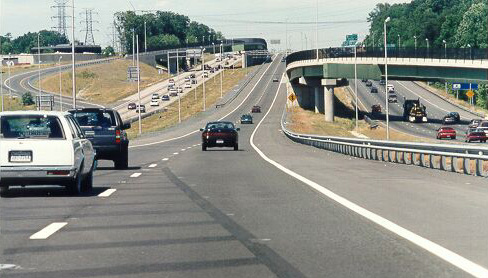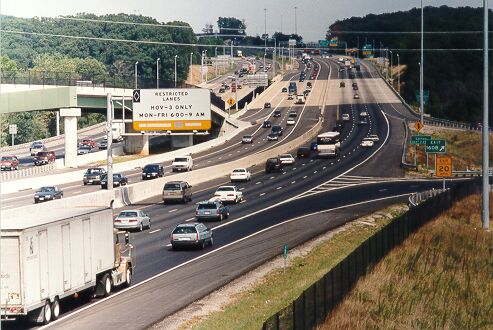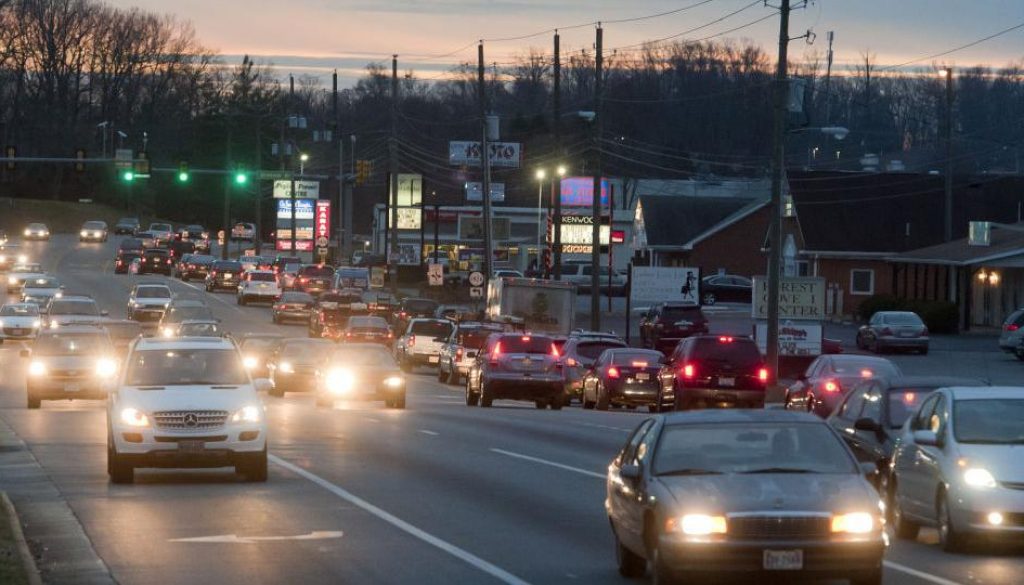HOV Lanes
HOV
Virginia has 113 miles of freeway HOV lanes, with 73 miles in Northern Virginia, and 40 miles in the Norfolk/Hampton Roads area. High-Occupancy Vehicle (HOV) lanes are highway lanes that are restricted to vehicles with a certain number of persons, for instance, an HOV-3 lane would be restricted to vehicles that have at least 3 people in them. Some HOV lanes are concurrent-flow (a left “diamond” lane), and others are completely barrier-separated. Usually but not always, an HOV lane is restricted during peak hours and open to all vehicles in non-peak hours.

I-95, looking northbound, taken August 1997, from VA-123 overpass at Woodbridge. Notice the bridge where I-95 crosses the Occoquan River; it is 868 feet long, and 11 lanes wide (8 through lanes). The center roadway is the reversible roadway that carries HOV-3 traffic during peak hours.
I-95 near Dale City, looking north, photo taken June 1997. The center reversible roadway was extended from Springfield to Dumfries, 19 miles; construction spanned from 1990 to 1997, cost was about $305 million. It carries HOV-3 traffic in the rush hour direction, unrestricted traffic otherwise. This section of I-95 was originally completed in 1965 and is actually south of the Shirley Highway portion. Notice the crossover ramps from each general-purpose roadway to the reversible roadway. “HOV-3” means that High Occupancy Vehicles with three or more people can use the road; those with fewer cannot.
I-95/I-395 (Shirley Highway) in Northern Virginia has a 27-mile barrier-separated HOV-3 reversible 2-lane roadway from south of VA-234 at Dumfries in Prince William County to South Eads Street near the Pentagon in Arlington County. The north end of the reversible roadway divides into 1.5 mile of conventional 4-lane divided express lanes (not HOV presently) that cross the 14th Street Bridge into D.C. and merge into 14th Street and the I-395 Southwest Freeway.
I-66 in Northern Virginia has 18 miles of an HOV-2 inner diamond lane each way from west of VA-234 at Manassas to I-495 Capital Beltway, and 9.6 miles of 2-lane exclusive HOV-2 in peak hours in peak direction, from I-495 to Rosslyn. I-66 from Rosslyn, across the Theodore Roosevelt Bridge, to its terminus in D.C. (about 1.5 mile) does not have HOV facilities. Dulles Airport SOV (single occupancy) traffic can use the highway at all times from Rosslyn to the Dulles Airport Access Road (DAAR). The eastern 3 miles of the DAAR is part of this HOV facility.
VA-267 Dulles Toll Road in Northern Virginia has15 miles of left diamond HOV-2 lanes.
I-64 in Norfolk has a 8-mile-long 2-lane barrier-separated reversible roadway for peak period HOV-2 traffic, and another 7 miles of left diamond HOV-2 lanes.
I-564 in Norfolk has 3 miles of left diamond HOV-2 lanes.
I-264 Norfolk-Virginia Beach Expressway (old VA-44) has 10 miles of left diamond HOV-2 lanes.
I-264 in Norfolk has 5 miles of left diamond HOV-2 lanes.
I-64 in Newport News and Hampton has 7 miles of left diamond HOV-2 lanes, with another 2.5 miles of left diamond HOV-2 lanes under construction to be completed in 2005.
The initial 11 miles of the reversible Shirley Highway busway opened in 1970, from Springfield to D.C., allowing express bus traffic in the rush-hour direction of traffic. This was the first such facility on a freeway in the nation.
In both metropolitan areas, major lengths of new freeway HOV lanes are planned, on I-95 extended south to Fredericksburg, on I-66 extended west to Gainesville, on I-64 extended west to Williamsburg, on I-64 extended west in Chesapeake, and on the Hampton Roads Third Crossing, and the Third Crossing would interconnect the I-64 HOV lanes on the Peninsula and in South Hampton Roads.

In all these existing HOV facilities, HOV lanes were added to an existing freeway, no existing general-purpose lanes were taken away. These Virginia HOV lanes move a tremendous volume of passengers in busses, car pools and van pools. Other areas can learn from Virginia’s example.
